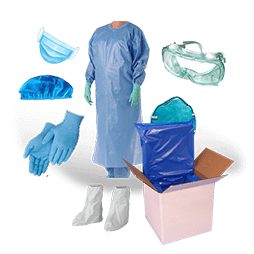
Types of Personal Protective Equipment (PPE)
Face coverings & accessories
Medical face coverings fall into three groups: surgical masks, procedure masks – also known as isolation masks – and N95 respirator masks. The CDC refers to them all as “medical masks,” but there are important differences.
The easiest way to tell them apart is that procedure masks affix with stretch loops behind the ears, while masks intended for use in surgery have two sets of ties for a more secure fit to the face. N95 respirator masks usually have over-the-head elastic bands to hold them firmly in place.
Both surgical and procedure masks for use in a medical setting are made with non-woven fabrics designed to protect the wearer and the patient from the transfer of microorganisms and large droplets and splashes of blood and other body fluids. They are disposable and only intended for single use.
Industry-standard “ASTM” test methods are used to measure mask performance. To carry an “ASTM Rating,” the FDA requires that masks be tested for:
- Fluid resistance
- Flame resistance
- Particulate filtration
- Bacterial filtration
- Breathability
A mask may be rated “ASTM Level 1, 2, or 3,” with the highest performance rated Level 3. But note that not all masks in the marketplace are ASTM-rated.
Personal Protective Gowns
There are various types of protective gowns, including surgical and isolation – or procedure – gowns. Gowns are rated according to their AAMI level, which indicates how a gown performs against a series of barrier performance criteria and ranges from one to four, with level 4 providing the highest barrier to fluids and microorganisms.
To aid in choosing the right gown for each use, AAMI-rated surgical and isolation gowns should all be clearly marked on the gown –not just on the packaging.
- AAMI Level 1: Minimal risk; to be used, for example, during basic care, standard isolation, a cover gown for visitors or in a standard medical unit
- AAMI Level 2: Low risk; to be used, for example, during the blood draw, suturing, in the intensive care unit (ICU) or a pathology lab
- AAMI Level 3: Moderate risk; to be used, for example, during the arterial blood draw, inserting an intravenous (IV) line, in the emergency room or for trauma cases
- AAMI Level 4: High risk; to be used, for example, during long, fluid intense procedures, surgery, when pathogen resistance is needed or when infectious diseases are suspected (non-airborne)
The highest barrier protection is in the primary “critical zones” of the gown, in the front and on the sleeves, where direct contact with blood, body fluids and other infectious material is likely to occur. Higher-level gowns have larger critical zones and the sleeves and seams are fully sealed, not sewn, to prevent fluid penetration.
AAMI Level 2 isolation or procedure gowns may be appropriate for minimally-invasive or in-office procedures where the fluid impact is expected to be low; whereas level 3 gowns are used for a wide range of surgeries where the risk is moderate and level 4 gowns are best for high-fluid and lengthy procedures when the risk is higher.
Medical Gloves
In general medical gloves consist of exam gloves, surgical gloves and chemotherapy cloves.
Exam gloves are generally less tight-fitting for easy donning and removal, come in fewer sizes, and can be worn on either hand.
Typically, surgical gloves are sterile, packaged in pairs, and “handed” with left and right gloves in each pair. They can be made of many materials, including nitrile, neoprene, polyisoprene, and latex. They come in many sizes and surgeons sometimes double-glove for extra protection from viral contamination or in procedures that involve heavy instruments, like orthopedics.
Chemotherapy gloves must be tested to resist a range of highly toxic hazardous drugs, according to ASTM testing. As users are often required to double-glove to prevent cross-contamination, chemo gloves come in under-glove and outer-glove combinations.
Hand Sanitizers
Hand hygiene is an important part of infection prevention, including during COVID-19. Practicing hand hygiene, which includes the use of alcohol-based hand rub or hand-washing, is a simple yet effective way to help prevent the spread of pathogens and infections in healthcare settings.
The Center for Disease Control & Prevention (CDC) recommends alcohol-based hand sanitizer at 60% ethanol or 70% isopropyl to kill COVID-19. Unless hands are visibly soiled, an alcohol-based hand rub is preferred over soap and water in most clinical situations due to evidence of better compliance compared to soap and water. Hand rubs are generally less irritating to hands and are effective in the absence of a sink.
